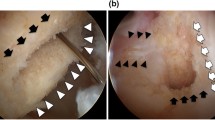Abstract
Purpose
Tibial bone destruction during primary graft tunnel placement and tibial bone loss following tunnel enlargement represent major challenges in revision reconstruction of the anterior cruciate ligament (ACL). Initial all-inside ACL reconstruction facilitates the preparation of tibial bone sockets rather than full tunnels that potentially preserve tibial bone stock. The purpose of this study was to comparatively assess length, diameter and volume of tibial graft tunnels following all-inside and conventional ACL reconstruction.
Methods
Postoperative computed tomography (CT) scans of 59 patients were assessed following ACL reconstruction. In 35 patients we used conventional antegrade tibial tunnel drilling and in 24 all-inside retrograde tibial bone sockets. Imaging analysis included total, minimal and maximal tunnel length and tunnel diameter. Tunnel volumes were calculated corresponding to these parameters.
Results
Statistically significant group differences (p < 0.01) could be detected for tibial tunnel volume, length and diameter between conventional antegrade and all-inside retrograde tibial bone tunnels and sockets, respectively.
Conclusions
Compared with conventional techniques, all-inside retrograde drilling of tibial bone sockets is effective in preserving significant bone stock, which might be beneficial for revision reconstruction in cases of eventual primary graft failure.


Similar content being viewed by others
References
Lubowitz JH, Konicek J (2013) Anterior cruciate ligament femoral tunnel length: cadaveric analysis comparing anteromedial portal versus outside-in technique. Arthroscopy 26:1357–1362
Lubowitz JH, Schwartzberg R, Smith P (2013) Randomized controlled trial comparing all-inside anterior cruciate ligament reconstruction technique with anterior cruciate ligament reconstruction with a full tibial tunnel. Arthroscopy 29:1195–1200
Lubowitz JH, Akhavan S, Waterman BR, Harandi-Aalami A, Konicek J (2013) Technique for anterior cruciate ligament femoral socket: optimizing femoral footprint anatomic restoration using outside-in drilling. Arthroscopy 29:522–528
Geeslin AG, Jansson KS, Wijdicks CA, Chapman MA, Fok AS, LaPrade RF (2011) Tibial tunnel aperture irregularity after drilling with 5 reamer designs. A qualitative micro–computed tomography analysis. Am J Sports Med 39:825–831
Iorio R, Di Sanzo V, Vadalà A, Conteduca J, Mazza D, Redler A, Bolle G, Conteduca F, Ferretti A (2013) ACL reconstruction with hamstrings: how different technique and fixation devices influence bone tunnel enlargement. Eur Rev Med Pharmacol Sci 17:2956–2961
McAdams TR, Biswal S, Stevens KJ, Beaulieu CF, Mandelbaum BR (2008) Tibial aperture bone disruption after retrograde versus antegrade tibial tunnel drilling: a cadaveric study. Knee Surg Sports Traumatol Arthrosc 16:818–822
Lee YS, Lee BK, Oh WS, Cho YK (2014) Comparison of femoral tunnel widening between outside-in and trans-tibial double-bundle ACL reconstruction. Knee Surg Sports Traumatol Arthrosc 22:2033–2039
Robbrecht C, Claes S, Cromheecke M, Mahieu P, Kakavelakis K, Victor J, Bellemans J, Verdonk P (2014) Reliability of a semi-automated 3D-CT measuring method for tunnel diameters after anterior cruciate ligament reconstruction: a comparison between soft-tissue single-bundle allograft vs. autograft. Knee 21:926–931
Yao J, Wen CY, Zhang M, Cheung JT, Yan C, Chiu KY, Lu WW, Fan Y (2014) Effect of tibial drill-guide angle on the mechanical environment at bone tunnel aperture after anatomic single-bundle anterior cruciate ligament reconstruction. Int Orthop 38:973–981
Mermerkaya MU, Atay OA, Kaymaz B, Bekmez S, Karaaslan F, Doral MN (2014) Anterior cruciate ligament reconstruction using a hamstring graft: a retrospective comparison of tunnel widening upon use of two different femoral fixation methods. Knee Surg Sports Traumatol Arthrosc. doi:10.1007/s00167-014-3034-1
Nebelung S, Deitmer G, Gebing R, Reichwein F, Nebelung W (2012) High incidence of tunnel widening after anterior cruciate ligament reconstruction with transtibial femoral tunnel placement. Arch Orthop Trauma Surg 132:1653–1663
Marchant BG, Noyes FR, Barber-Westin SD, Fleckenstein C (2010) Prevalence of nonanatomical graft placement in a series of failed anterior cruciate ligament reconstructions. Am J Sports Med 38:1987–1996
Marchant MH, Willimon SC, Vinson E, Pietrobon R, Garrett WE, Higgins LD (2010) Comparison of plain radiography, computed tomography, and magnetic resonance imaging in the evaluation of bone tunnel widening after anterior cruciate ligament reconstruction. Knee Surg Sports Traumatol Arthrosc 18:1059–1064
Neddermann A, Willbold E, Witte F, Hurschler C, Hankemeier S, Stübig T, Hesse E, Fehr M, Krettek C, Meller R (2009) Tunnel widening after anterior cruciate ligament reconstruction. An experimental study in sheep. Am J Sports Med 37:1609–1617
MARS Group (2013) Radiographic findings in revision anterior cruciate ligament reconstructions from the MARS cohort. Knee Surg 26:239–248
Author information
Authors and Affiliations
Corresponding author
Rights and permissions
About this article
Cite this article
Osti, M., Krawinkel, A., Hoffelner, T. et al. Quantification of tibial bone loss in antegrade versus retrograde tunnel placement for anterior cruciate ligament reconstruction. International Orthopaedics (SICOT) 39, 1611–1614 (2015). https://doi.org/10.1007/s00264-015-2668-z
Received:
Accepted:
Published:
Issue Date:
DOI: https://doi.org/10.1007/s00264-015-2668-z




